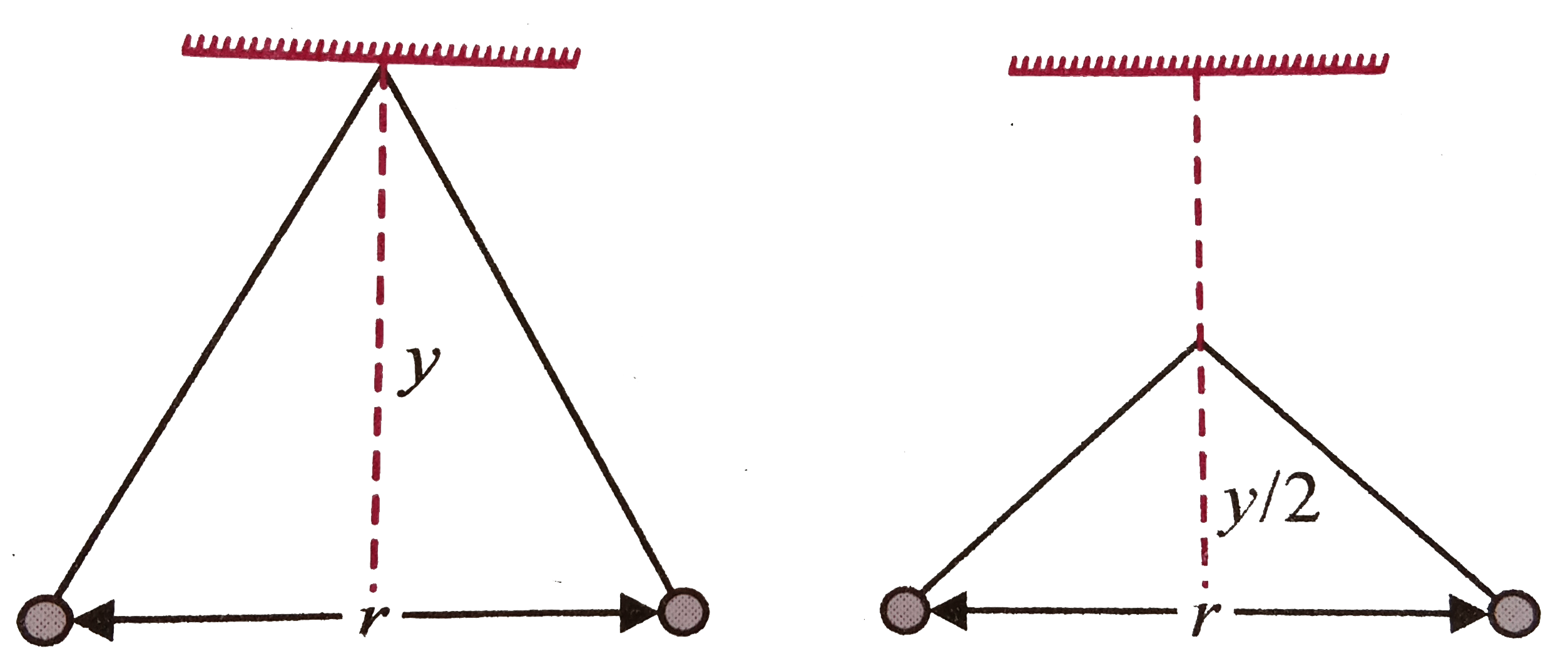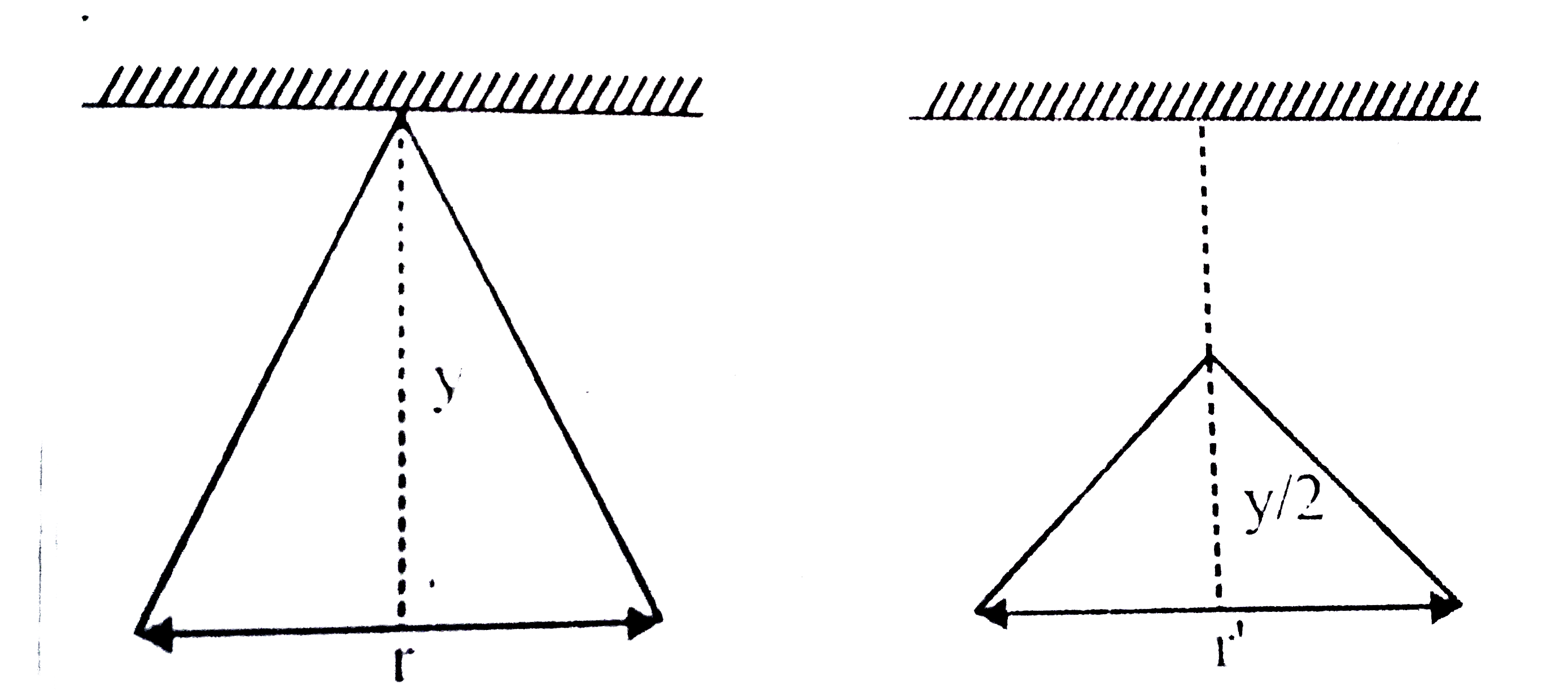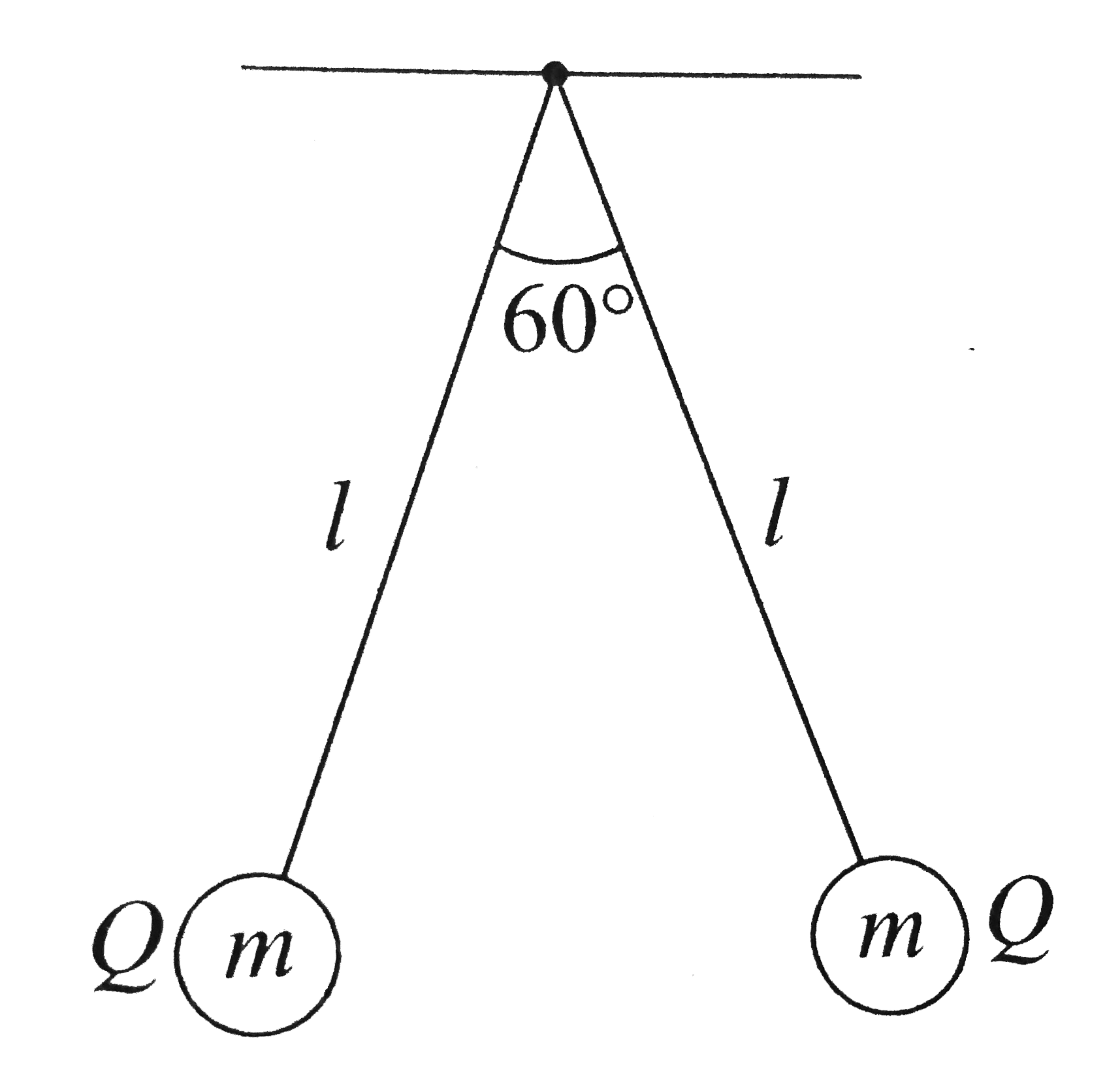Two identical balls each having a density ρ are suspended from as common point by two insulating strings of equal length. Both the balls have equal mass and charge. In equilibrium each string makes an angle θ with vertical. Now, both the balls are immersed in a liquid. As a result the angle θ does not change. The density of the liquid is σ. Find the dielectric constant of the liquid.
The correct Answer is:A
To solve the problem, we need to analyze the forces acting on the two identical balls in both scenarios: when they are suspended in air and when they are immersed in a liquid.
1. Understanding the Initial Setup:
- We have two identical balls, each with mass m, density ρ, and charge Q.
- The balls are suspended by insulating strings of length l, making an angle θ with the vertical.
- In equilibrium, the forces acting on each ball must balance.
2. Forces in Air:
- The forces acting on each ball are:
- Weight W=mg=ρVg (where V is the volume of the ball).
- Tension T in the string.
- Electrostatic force Fe due to the repulsion between the two charged balls.
- The vertical component of the tension balances the weight:
Tcosθ=ρVg(1)
- The horizontal component of the tension balances the electrostatic force:
Tsinθ=Fe(2)
3. Dividing the Forces:
- Dividing equation (2) by equation (1):
TsinθTcosθ=FeρVg
- This simplifies to:
tanθ=FeρVg(3)
4. Forces in the Liquid:
- When the balls are immersed in a liquid of density σ, the buoyant force FB acts upwards:
FB=σVg
- The new tension in the string is T′.
- The vertical component of the tension plus the buoyant force balances the weight:
T′cosθ+σVg=ρVg(4)
- The horizontal component of the tension still balances the electrostatic force, but now it is modified by the dielectric constant Er:
T′sinθ=FeEr(5)
5. Dividing the Forces in Liquid:
- Dividing equation (5) by equation (4):
T′sinθT′cosθ+σVg=FeEr(ρVg−σVg)
- This simplifies to:
tanθ=FeEr(ρ−σ)g(6)
6. Equating the Two Scenarios:
- From equations (3) and (6):
FeρVg=FeEr(ρ−σ)g
- Canceling Fe and g from both sides:
1ρ=1Er(ρ−σ)
- Rearranging gives:
Er=ρρ−σ
Final Answer:
The dielectric constant of the liquid is given by:
Er=ρρ−σ
- We have two identical balls, each with mass m, density ρ, and charge Q.
- The balls are suspended by insulating strings of length l, making an angle θ with the vertical.
- In equilibrium, the forces acting on each ball must balance.
- The forces acting on each ball are:
- Weight W=mg=ρVg (where V is the volume of the ball).
- Tension T in the string.
- Electrostatic force Fe due to the repulsion between the two charged balls.
- The vertical component of the tension balances the weight:
Tcosθ=ρVg(1)
- The horizontal component of the tension balances the electrostatic force:
Tsinθ=Fe(2)
- Dividing equation (2) by equation (1):
TsinθTcosθ=FeρVg
- This simplifies to:
tanθ=FeρVg(3)
- When the balls are immersed in a liquid of density σ, the buoyant force FB acts upwards:
FB=σVg
- The new tension in the string is T′.
- The vertical component of the tension plus the buoyant force balances the weight:
T′cosθ+σVg=ρVg(4)
- The horizontal component of the tension still balances the electrostatic force, but now it is modified by the dielectric constant Er:
T′sinθ=FeEr(5)
- Dividing equation (5) by equation (4):
T′sinθT′cosθ+σVg=FeEr(ρVg−σVg)
- This simplifies to:
tanθ=FeEr(ρ−σ)g(6)
- From equations (3) and (6):
FeρVg=FeEr(ρ−σ)g
- Canceling Fe and g from both sides:
1ρ=1Er(ρ−σ)
- Rearranging gives:
Er=ρρ−σ
The dielectric constant of the liquid is given by:
Er=ρρ−σ
Topper's Solved these Questions
- BOOK - DC PANDEY ENGLISHCHAPTER - ELECTROSTATICSEXERCISE - Example Type 55videos
ELECTROSTATICS
- BOOK - DC PANDEY ENGLISHCHAPTER - ELECTROSTATICSEXERCISE - Example Type 64videos
ELECTROSTATICS
- BOOK - DC PANDEY ENGLISHCHAPTER - ELECTROSTATIC POTENTIAL AND CAPACITORSEXERCISE - (C) Chapter exercises50videos
ELECTROSTATIC POTENTIAL AND CAPACITORS
- BOOK - DC PANDEY ENGLISHCHAPTER - GRAVITATIONEXERCISE - All Questions135videos
GRAVITATION
Similar Questions
Two identical pith balls, each carrying charge q, are suspended from a common point by two strings of equal length l. Find the mass of each ball if the angle between the strings is 2θ in equilibrium.
View SolutionTwo indentical pith balls, each carrying charge q, are suspended from a common point by two strings of equal length l. Find the mass of each ball if the angle between the strings is 2θ in equilibrium.
View SolutionTwo path balls carrying equal charges are suspended from a common point by strings of equal length, the strings are rightly clamped at half the height. The equilibrium separation between the balls, now becomes :
 View Solution
View SolutionTwo small spheres, each having a mass of 20 g, are suspended form a common point by two insulating strings of length 40 cm each. The spheres are identically charged and the speration between the balls at equilibrium is found to be 4 cm . Find the charge on each sphere.
View SolutionTwo identical balls , each having a charge q and mass m , are suspended from a common point by two insultating strings each of length L. The balls are held at a separation x and then released. Find
(a) the electric force on each ball
(b) the component of the resultant force on a ball along and perpendicular to string
(c ) the tension in the string
(d) the acceleration of one of the balls. Consider the situation only for the instant just after the release.View SolutionTwo pitch balls carrying equal charges are suspended from a common point by strings of equal length, the equilibrium separation between them is r. Now the strings are rigidly clamped at half the height. The equilibrium separation between the balls now become
 View Solution
View SolutionTwo small balls, each having equal positive charge Q are suspended by two insulationg strings of equal length l from a hook fixed to a stand. It mass of each ball =m and total angle between the two strings is 60∘m, then find the charge on each ball.
 View Solution
View SolutionTwo identical charged spheres are suspended by strings of equal lengths. The strings make an angle of 30∘ with each other. When suspended in a liquid of density 0.8gcm−3, the angle remains the same. If density of the material of the sphere is 1.6gcm−3, the dielectric constant of the liquid is
View SolutionTwo identical charged spheres are suspended by strings of equal lengths. The strings make an angle of 30∘ with each other. When suspended in a liquid of density 0.8gcm−3, the angle remains the same. If density of the material of the sphere is 1.6gcm−3, the dielectric constant of the liquid is
View SolutionTwo identical charged spheres of material density ρ, suspended from the same point by inextensible strings of equal length make an angle θ between the string. When suspended in a liquid of density σ the angle θ remains the same. The dielectric constant K of the liquid is
View Solution

